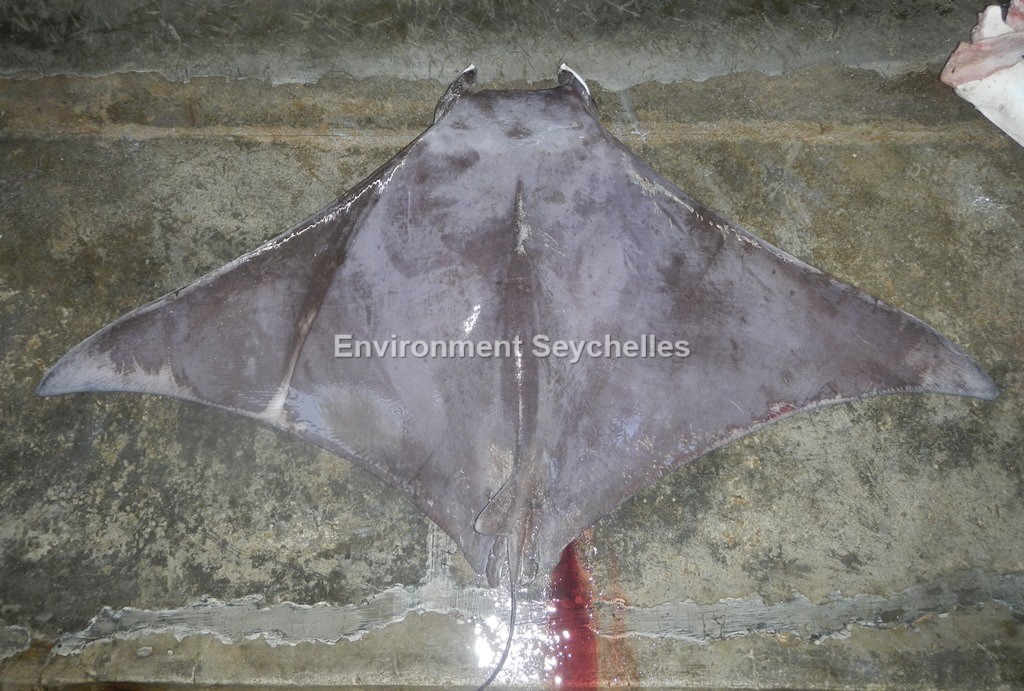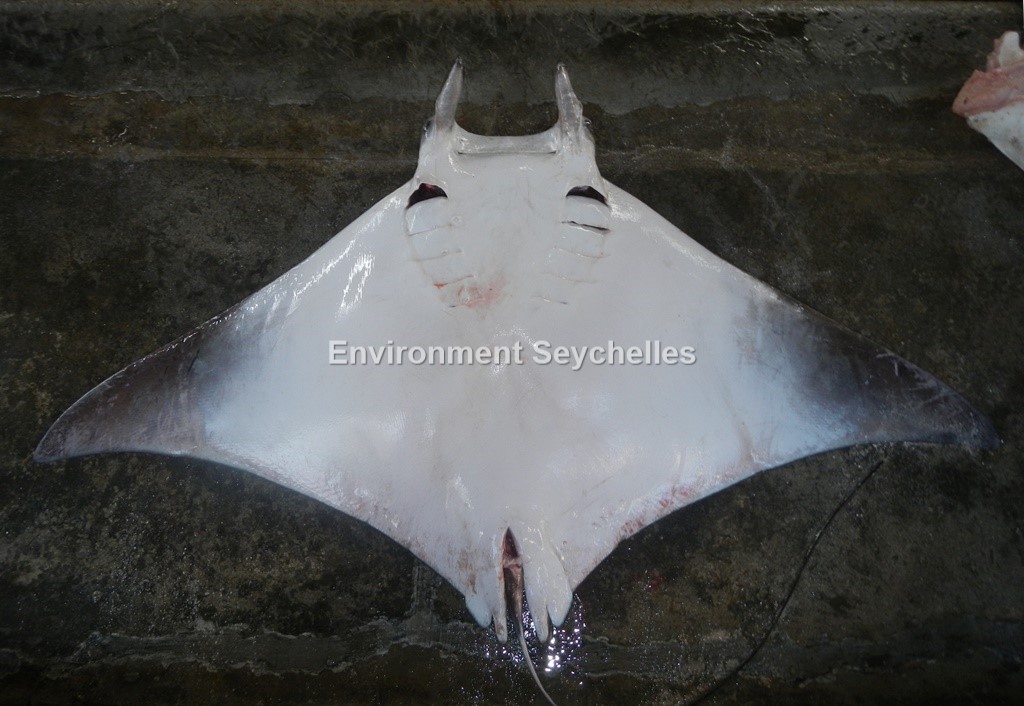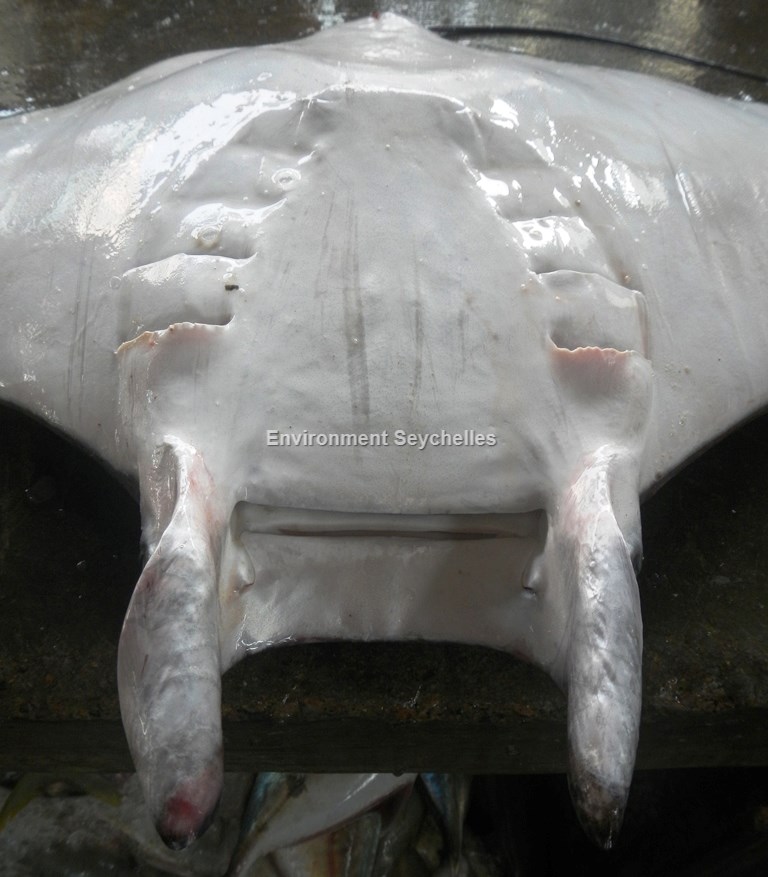Description:
Small devil ray with a broad and sub- terminal mouth. Anterior margins of disc straight to slightly convex. Spiracles small, circular and located below pectoral fin origins.
Base of tail quadrangular in cross-section, and no caudal spine present. Disc broad and short, length 50 to 59% of width. Denticles mostly absent. Tail whiplike and long,
greater than disc in juveniles, shorter than disc width in adults. Dorsal fin small, apex broadly rounded.
Colour. Dorsal surface purplish-brown to brown; dorsal fin plain or with a white tip. Ventral surface white except for distal portions of disc which are dusky grey.
Size:
Maturity: Born: 31-34cm DW. Maturity: males at approx. 115cm DW, females at approx.134cm DW. Maximum: attains at least 135cm DW.
Habitat and Ecology:
Found in coastal and oceanic waters. Generally found in schools, leaping out of the water. Feeds on planktonic crustaceans and possibly small fishes and cephalopods.
Ovoviviparous, with embryos feeding initially on yolk, then receiving additional nourishment from the mother by indirect absorption of uterine fluid enriched with mucus,
fat or protein through specialised structures. A single, relatively large pup is produced per litter.
Fishery Status:
This species is not protected or subject to fishery regulations despite being an appendix I species under the Convention on Migratory species to which Seychelles is party.
It is caught in gill nets. It is a periodic and occasionally numerous component of the catch.
Notes:
References:
Bizzarro, J. et al (2009). Mobula kuhlii. The IUCN Red List 2009: e.T161439A5424139. http://dx.doi.org/10.2305/IUCN.UK.2009-2.RLTS.T161439A5424139.en. (27/05/19).
Froese, R. & D. Pauly. Eds. (2018). FishBase. https://www.fishbase.de/summary/27177 (27/05/19).
Last, P.R. et al (2016). Rays of the World. CSIRO Publishing ISBN 9781501705328
Rigby, C.L. et al (2020). Mobula kuhlii. The IUCN Red List 2020: e.T161439A124485584. https://www.iucnredlist.org/species/161439/124485584fbclid=IwAR2LtUz6lLRbS4r1tEHPU7jr1fpxIJcaqk93SnNfDNRTcggeAk8Y1ADiRn0 (10/07/20)
Citation:
Nevill, J.E.G. (2019). Mobula kuhlii, Shortfin devil ray. Seychelles Seatizens. www.seatizens.sc. https://seatizens.sc/species/mobula-kuhlii-muller-henle-1841/ (Updated 29/09/21).




pin up azerbaijan: pin up giris – pin up azerbaycan yukle
pharmacies in mexico that ship to usa northern doctors reputable mexican pharmacies online
mexican rx online: mexican pharmacy – п»їbest mexican online pharmacies
https://northern-doctors.org/# best online pharmacies in mexico
mexico drug stores pharmacies: northern doctors pharmacy – medication from mexico pharmacy
mexico pharmacies prescription drugs: mexican pharmacy northern doctors – buying from online mexican pharmacy
https://northern-doctors.org/# reputable mexican pharmacies online
mexican border pharmacies shipping to usa: mexican pharmacy online – mexico pharmacy
https://northern-doctors.org/# buying prescription drugs in mexico online
purple pharmacy mexico price list: mexico drug stores pharmacies – mexican border pharmacies shipping to usa
https://northern-doctors.org/# mexico pharmacies prescription drugs
https://northern-doctors.org/# pharmacies in mexico that ship to usa
pharmacies in mexico that ship to usa: mexican pharmacy northern doctors – reputable mexican pharmacies online
purple pharmacy mexico price list mexican pharmacy medication from mexico pharmacy
mexico pharmacies prescription drugs: mexican drugstore online – reputable mexican pharmacies online
https://northern-doctors.org/# medicine in mexico pharmacies
pharmacies in mexico that ship to usa: northern doctors – mexican pharmacy
https://northern-doctors.org/# buying prescription drugs in mexico online
http://northern-doctors.org/# medicine in mexico pharmacies
mexican mail order pharmacies: mexican pharmacy online – pharmacies in mexico that ship to usa
mexico pharmacy: mexican pharmacy – reputable mexican pharmacies online
https://northern-doctors.org/# best online pharmacies in mexico
http://northern-doctors.org/# mexican border pharmacies shipping to usa
mexican online pharmacies prescription drugs northern doctors medication from mexico pharmacy
mexico pharmacies prescription drugs: Mexico pharmacy that ship to usa – mexico drug stores pharmacies
mexico pharmacies prescription drugs mexican pharmacy online mexican rx online
https://northern-doctors.org/# mexico drug stores pharmacies
http://northern-doctors.org/# mexico drug stores pharmacies
buying prescription drugs in mexico online: Mexico pharmacy that ship to usa – п»їbest mexican online pharmacies
mexican border pharmacies shipping to usa: northern doctors pharmacy – buying prescription drugs in mexico
reputable mexican pharmacies online medication from mexico pharmacy best online pharmacies in mexico
pharmacies in mexico that ship to usa reputable mexican pharmacies online mexican pharmaceuticals online
https://northern-doctors.org/# best online pharmacies in mexico
mexican online pharmacies prescription drugs: Mexico pharmacy that ship to usa – mexican online pharmacies prescription drugs
https://northern-doctors.org/# mexican border pharmacies shipping to usa
mexican drugstore online: mexican pharmacy online – mexican mail order pharmacies
mexico drug stores pharmacies: mexican pharmacy – mexican pharmacy
https://northern-doctors.org/# medicine in mexico pharmacies
mexican rx online: mexican pharmacy northern doctors – mexico pharmacies prescription drugs
mexico drug stores pharmacies northern doctors pharmacy reputable mexican pharmacies online
reputable mexican pharmacies online: northern doctors pharmacy – mexican drugstore online
http://northern-doctors.org/# mexico pharmacy
mexican mail order pharmacies: mexico drug stores pharmacies – buying from online mexican pharmacy
https://northern-doctors.org/# best online pharmacies in mexico
medication from mexico pharmacy: mexican pharmacy northern doctors – mexican border pharmacies shipping to usa
medication from mexico pharmacy: Mexico pharmacy that ship to usa – п»їbest mexican online pharmacies
mexico drug stores pharmacies: pharmacies in mexico that ship to usa – mexico pharmacies prescription drugs
Great read! The depth and clarity of your analysis are impressive. If anyone is interested in diving deeper into this subject, check out this link: DISCOVER MORE. Looking forward to everyone’s thoughts!
https://northern-doctors.org/# п»їbest mexican online pharmacies
mexico pharmacies prescription drugs: mexican pharmacy online – purple pharmacy mexico price list
mexico pharmacies prescription drugs mexican pharmacy mexican rx online
mexican drugstore online: northern doctors – medicine in mexico pharmacies
https://northern-doctors.org/# mexican rx online
mexican pharmaceuticals online northern doctors mexico pharmacies prescription drugs
buying prescription drugs in mexico: northern doctors pharmacy – purple pharmacy mexico price list
п»їbest mexican online pharmacies: pharmacies in mexico that ship to usa – mexico pharmacies prescription drugs
buying prescription drugs in mexico: mexican pharmacy northern doctors – п»їbest mexican online pharmacies
medication from mexico pharmacy: northern doctors pharmacy – mexico pharmacy
mexican drugstore online: northern doctors pharmacy – mexican drugstore online
https://northern-doctors.org/# mexican pharmacy
medicine in mexico pharmacies: mexican northern doctors – mexico drug stores pharmacies
http://northern-doctors.org/# medication from mexico pharmacy
mexico drug stores pharmacies mexican pharmacy online buying prescription drugs in mexico
purple pharmacy mexico price list: northern doctors – purple pharmacy mexico price list
best online pharmacies in mexico: northern doctors pharmacy – buying prescription drugs in mexico online
mexico pharmacy: mexican northern doctors – mexico pharmacy
mexican mail order pharmacies: Mexico pharmacy that ship to usa – pharmacies in mexico that ship to usa
https://northern-doctors.org/# medicine in mexico pharmacies
http://cmqpharma.com/# mexico drug stores pharmacies
mexico drug stores pharmacies
buy medicines online in india: best india pharmacy – india online pharmacy
mexican border pharmacies shipping to usa: mexican border pharmacies shipping to usa – mexico pharmacy
Online medicine home delivery: reputable indian pharmacies – india pharmacy
https://foruspharma.com/# pharmacies in mexico that ship to usa
northwest canadian pharmacy: real canadian pharmacy – canadian pharmacy review
online canadian pharmacy: canada drug pharmacy – canadian drugs
buy canadian drugs: thecanadianpharmacy – pharmacy com canada
online canadian pharmacy: canadian world pharmacy – buy canadian drugs
canadian pharmacy king reviews online canadian pharmacy review canadapharmacyonline
world pharmacy india: india pharmacy – world pharmacy india
buying prescription drugs in mexico: best online pharmacies in mexico – mexican pharmacy
п»їlegitimate online pharmacies india indian pharmacy india online pharmacy
top online pharmacy india: top online pharmacy india – indian pharmacy online
http://foruspharma.com/# mexican drugstore online
canada drug pharmacy: adderall canadian pharmacy – buy canadian drugs
top 10 online pharmacy in india: world pharmacy india – reputable indian online pharmacy
mexico pharmacy: buying from online mexican pharmacy – buying from online mexican pharmacy
mexican online pharmacies prescription drugs: mexican pharmacy – mexican border pharmacies shipping to usa
best canadian online pharmacy: canadian pharmacy no scripts – canadian pharmacy meds review
indian pharmacy online: Online medicine order – india pharmacy
https://foruspharma.com/# purple pharmacy mexico price list
top online pharmacy india: reputable indian pharmacies – best india pharmacy
It’s nearly impossible to find educated people about this subject, but you sound like you know what you’re talking about! Thanks
mexico drug stores pharmacies: best online pharmacies in mexico – buying prescription drugs in mexico online
https://clomiddelivery.pro/# get cheap clomid no prescription
https://doxycyclinedelivery.pro/# doxycycline 20 mg india
cost of cheap clomid no prescription: where to buy cheap clomid – buying clomid
http://amoxildelivery.pro/# amoxicillin online no prescription
Excellent blog you’ve got here.. It’s hard to find high quality writing like yours these days. I seriously appreciate people like you! Take care!!
https://ciprodelivery.pro/# cipro 500mg best prices
http://paxloviddelivery.pro/# paxlovid buy
I used to be able to find good info from your blog articles.
http://paxloviddelivery.pro/# Paxlovid over the counter
cipro for sale: ciprofloxacin mail online – buy ciprofloxacin
http://doxycyclinedelivery.pro/# where to get doxycycline in singapore
https://doxycyclinedelivery.pro/# doxycycline buy
http://ciprodelivery.pro/# antibiotics cipro
where can i buy amoxicillin without prec: amoxicillin 250 mg – purchase amoxicillin 500 mg
doxycycline pills buy: doxycycline pills online – doxycycline 200 mg capsules
https://ciprodelivery.pro/# cipro 500mg best prices
https://ciprodelivery.pro/# buy cipro online without prescription
https://paxloviddelivery.pro/# paxlovid pill
buy paxlovid online: paxlovid generic – Paxlovid over the counter
https://clomiddelivery.pro/# clomid brand name
https://doxycyclinedelivery.pro/# buy doxycycline without prescription
https://clomiddelivery.pro/# where buy cheap clomid without rx
amoxicillin azithromycin: amoxicillin 500mg price – cost of amoxicillin 875 mg
https://doxycyclinedelivery.pro/# doxycycline monohydrate
Your style is unique in comparison to other people I have read stuff from. Thank you for posting when you have the opportunity, Guess I will just book mark this web site.
https://clomiddelivery.pro/# order generic clomid for sale
http://paxloviddelivery.pro/# paxlovid covid
cost doxycycline 100mg: cheapest doxycycline 100mg – doxycycline uk cost
amoxil pharmacy: amoxicillin 500 mg for sale – amoxicillin online pharmacy
paxlovid cost without insurance: п»їpaxlovid – paxlovid india